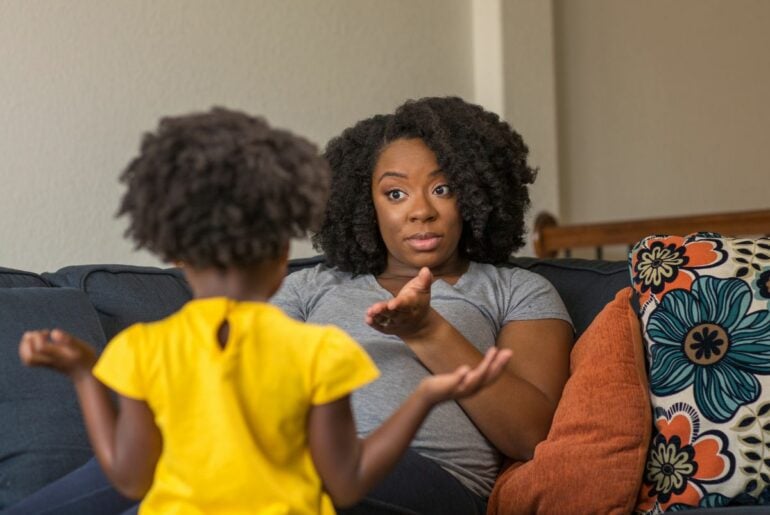The older your kids get, the more rules and discipline they can handle. But what does discipline look like for a very young child? Of course, you’ve got to keep your expectations reasonable with little ones — but a little discipline can actually go a long way with kids under six!
Punishment (things like scolding or spanking) won’t be very effective for this age group (or any age group, honestly!), but introducing discipline is a great way to teach them about boundaries and values from the start. Here’s a helpful breakdown of age-appropriate discipline strategies for kids under six!
Discipline for 1-year-olds
At first, it may not seem like it’s even possible to discipline a 1-year-old. They’re still so little! But discipline for kids this young will help them internalize that their actions have consequences, which will help them make better choices as they get older.
Here’s what age-appropriate discipline for a 1-year-old looks like —
- Setting an example. Model the behavior you want to see from your child.
- Setting clear boundaries. If you don’t want them to play with your phone, don’t give in!
- Redirection. For example, trade them a safe toy for an off-limits item like earrings or a power cord.
- Empathy and patience. Comfort and distract them during their meltdowns. They will happen either way, so responding with kindness will help it pass more quickly.
- Praising good behavior. Make a big deal about it when they do the right thing! Celebrating their successes will make them want to keep repeating those behaviors.
- Keeping your expectations reasonable. Don’t give your 1-year-old complex rules or routines to follow. Stick to the basics and build from there as they grow.
Discipline for 2-year-olds
They don’t call it the “terrible twos” for nothing! While it’s perfectly normal developmentally, this is the age when little ones start testing boundaries…and your patience. They also have really big feelings at this age, because they haven’t yet developed any emotional regulation skills. Tantrums are common, and are a totally normal and natural part of child development.
Discipline and redirection can be helpful tools in your parenting toolbox. And making boundaries clear and consistent can help kids follow the rules more easily!
Here’s what age-appropriate discipline for a 2-year-old looks like —
- Minimizing power struggles. Make your expectations clear and easy to follow, and remember that it’s their job to test you! You might try offering incentives for positive behavior.
- Giving them language for their feelings. Verbalize what they might be feeling, and narrate the consequences of their actions. For example, if they hit someone, you can say, “You must be angry. Being angry is OK, but hitting hurts. Let’s use gentle hands.”
- Responding to tantrums with patience. Don’t give into their demands, but stay with them and offer empathy.
- Offering simple choices. Rather than letting their big feelings run the show, provide them with some choices. “Sorry, you may not have ice cream for dinner. Would you rather have pasta or a sandwich?” Giving them two options to choose from lets them feel like they have some control (which makes them less likely to dig their heels in and fight back).
- Redirecting them towards positive behavior. For example, “Jumping off the couch might hurt you. Let’s see how sloooowly you can get off the couch instead!”
Discipline for 3-year-olds
Kids this age are just beginning to assert their independence, which can lead to some nasty power struggles. Neurotypical 3-year-olds can typically follow simple instructions and handle short time-ins to calm down, so it’s a good time to introduce some logical consequences for unwanted behaviors.
However, they haven’t developed a ton of long-term memory yet, so their ability to follow through with tasks is limited. Have patience! Reserve age-appropriate consequences for things like aggressive or dangerous behaviors.
Here’s what appropriate discipline for a neurotypical 3-year-old might look like —
- Positive reinforcement. Praise their efforts to help out, but let it go if they don’t follow through.
- Working routines and rules into playtime. For example, play a song and have your child try to complete 3 tasks to get ready to go to childcare before it ends!
- Enforcing rules in the moment. Three-year-olds won’t remember why they’re in trouble if you save the consequences for a more convenient time.
- 3-minute time-ins. We recommend reserving these for when a break from the action would be helpful, like when they’re becoming overstimulated or aggressive. Three minutes or less is about all they can handle at this age! Any longer and they’ll forget why they’re sitting there.
- Focusing on natural consequences (what happens naturally when you don’t intervene). For example, if you remind them to pull their sleeves up before washing their hands and they don’t, their sleeves will get wet. Of course sometimes a natural consequence isn’t safe, like touching the stove to learn that it’s hot — and sometimes the natural consequence doesn’t motivate kids to do anything differently, like staying dirty if they refuse to take a bath. Use your best judgment!
Discipline for 4- and 5-year-olds
Kids this age are becoming more socially independent and learning new skills every day! But along with these exciting new developments also come things like whining, lying, and pushing your boundaries to test the limits.
Many neurotypical 4- and 5-year-olds however, are also better equipped at their age to follow more rules and handle more discipline.
Here’s how age-appropriate discipline for a 4- or 5-year-old might look —
- Introducing a behavior management system. Encourage behaviors you want to see by making a chart with positive behaviors listed, like cleaning up after themselves or sharing with a sibling, and give them a sticker when they do those behaviors. They can earn a prize each time they complete a row of stickers!
- Using a timer. Many kids are visual learners! You can set a timer for one or two minutes to show kids how much time they have to complete a certain task or transition, or to count down the amount of time they have to fix a behavior before there’s a consequence. Similarly, you can mark the face of an analog clock to show kids where the hands point when it’s time for different parts of your routine, like breakfast or bedtime. Over time that can help kids visualize what’s coming up next and how long it will be until it starts.
- 4- or 5-minute time-ins. Have them take a 4- or 5-minute break from what they’re doing if they can’t use gentle hands or words, or just need to settle down a bit.
- Appealing to their developing sense of empathy. Kids this age are starting to be able to put themselves into other peoples’ shoes. When they’re aggressive or thoughtless, ask them to imagine what it would be like if someone treated them that way.
- Gently redirecting behaviors like whining or lying. These are natural phases most kids go through, so remind them what the preferred behavior is without shaming them, and try to exercise patience!
All of these discipline strategies are best suited for neurotypical kids under six years old. You know your child best, so use this guide as a general rule of thumb, while applying the best strategies that you know work for your child!







